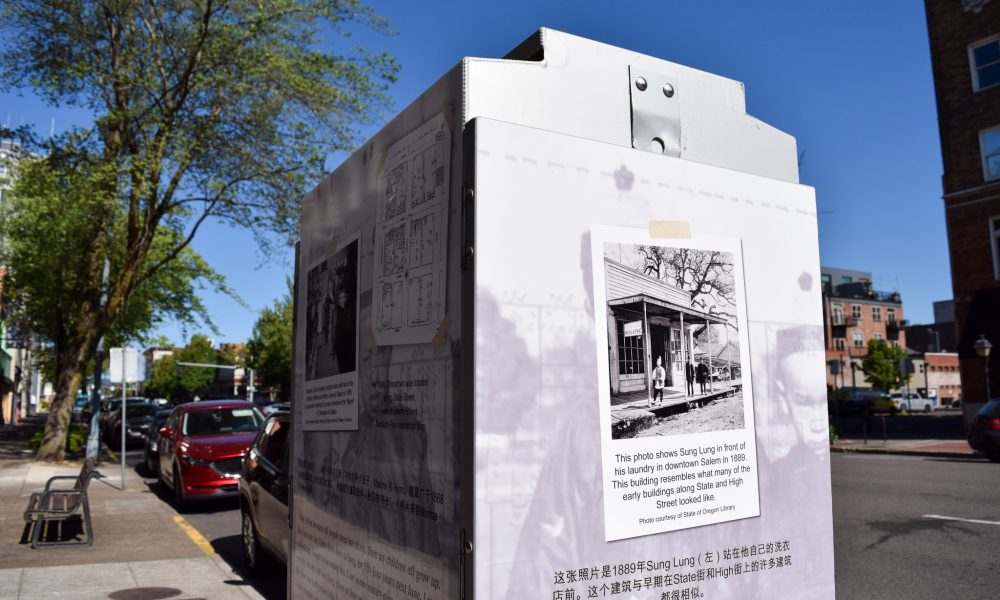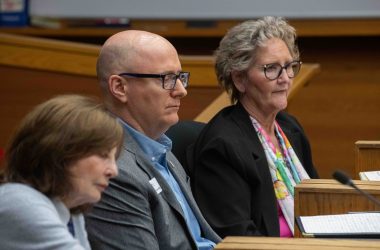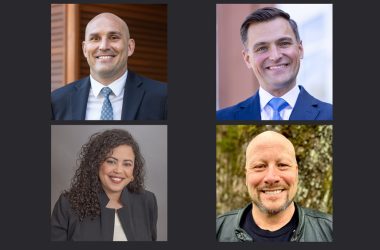
A utility box panel explaining the history of Salem’s Chinatown sits at the corner of State Street and High Street Northeast. (Saphara Harrell/Salem Reporter)
You may have noticed something different about the utility boxes in downtown Salem.
Seven of the city’s metal enclosures for electrical equipment now have a museum-like panel, describing different aspects of the city’s history.
Pedestrians can now read about Salem’s theaters, moving buildings, Mission Street, amusement, Chinatown, indigenous art, and the Chinese section of a local cemetery.
“The hope is that Salem residents and visitors can learn a little bit about Salem’s history and especially as it relates to the places that they are living and working in today,” said Kimberli Fitzgerald, the city’s historic preservation officer.
[ KEEP YOUR LOCAL NEWS STRONG – SUBSCRIBE ]
“People go to work and they live and they see these wonderful buildings in these places and they don’t necessarily know the history around them,” she said.
Fitzgerald headed up a project a couple years ago that uncovered a Chinese shrine in Pioneer Cemetery, off of Commercial Street Southeast and Hoyt Street Southeast.
In addition to revealing the shrine, the work also unearthed a piece of Salem history that not many knew about.
“It’s going to be very surprising to most people as it was to us. We didn’t realize there was a Chinatown here,” Fitzgerald said.
She said the city hadn’t done much interpretation of the history of minority races in the area. When the federal Advisory Council on Historic Preservation recommended that local jurisdictions focus on interpreting the history of underrepresented communities, Fitzgerald got to work.
She traveled to China last year to find family members of those who lived in Salem’s Chinatown and got funding for the trip through Portland State University while pursuing her master’s degree there, while also working for the city.
Fitzgerald was able to use four headstones from Pioneer Cemetery to determine the last name and birthplace of people who had immigrated to Salem.
She worked with a university in China, got a guide and went to four small villages. One of the villages was the birthplace of the former mayor of Salem’s Chinatown. Fitzgerald found out George Lai Sun had sent money back to the village and saw buildings that were constructed using the money he had sent.
Fitzgerald said one of the main reasons Chinese people came to America in the 1800s was because of a financial crisis and famine.
When family members left to come to the states, “In some cases they never heard from them again. They didn’t know what had happened,” Fitzgerald said.

A panel describing public amusement in Salem sits at the corner of Liberty Street Northeast and Court Street Northeast. (Saphara Harrell/Salem Reporter)
When the panel project started coming together, Fitzgerald said she was conscious of having them translated so people could engage with the content in their native language.
Unlike the other interpretive signs around town, the panels are inexpensive and easy to fix.
Fitzgerald said all of them cost less than $3,000 to install and each cost under $200 to fix if something happens.
The project took nearly a year to put together, because the city collaborated with local cultural groups to decide what was going to go on the panels and where.
Yvonne Putze was one of the collaborators on the Mission Street portion.
The executive director of Deepwood Museum and Gardens said the panels make Salem history more approachable, like a chance meeting.
Putze recalled watching someone walking by at a quick pace, stopping and turning around to take a look at a panel.
“Even though they obviously appeared to be in a hurry, it was captivating enough,” she said. “It’s just an element of surprise for people.”
Putze said she loved the idea the first time she heard about it – taking a utilitarian object and making it intriguing.
She said there’s a lot of history that’s lost, and local history isn’t deeply taught in schools.
“All of us [cultural organizations] need to help do that in our community,” Putze said.
The panel titled “Salem’s Moving Past” focuses on all the buildings that were moved to save them from demolition.
“The funniest I always find is the old post office, which is now Gatke Hall at Willamette,” Fitzgerald said.
She said it took a year or more to move the building on rollers, because they only moved it a couple inches a day.
Fitzgerald said there’s an opportunity to do more of the historic wraps around the community, and public feedback is important to that process. Next month the city is launching a community survey .
Three of the panels are located on Court Street Northeast, between Liberty Street Northeast and Church Street Northeast. Two are located on State Street between High Street Northeast and Cottage Street Northeast. The Mission Street panel is located on the corner of Mission Street Southeast and High Street Southeast. The shrine panel is located on Pioneer Cemetery.
Have a tip? Contact reporter Saphara Harrell at 503-549-6250, [email protected] or @daisysaphara.









